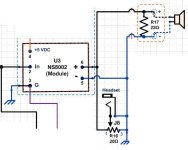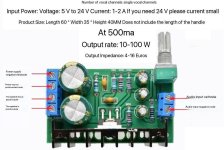Mooly,I think so on balance. While Mark makes a valid point, the 4562 (and many others) while certainly 'better' are also devices that demand much more care in layout and implementation. Your 33171's should be docile to implement. You could equally use the common 741.
I've attached the NS8002 section as well as the "spec sheet."
From the literature for this device I am just not certain whether or not I can ground the speaker negative.
I'm starting to think I should not. Would there still be proper return if not chasis-grounded?
-R
Attachments
Note the much higher noise levels of the 33171 and 741, 29 and 40nV/√Hz respectively - 15 to 20dB noisier than some - whether this is an issue in this circumstance I don't know, but its worth knowing about before choosing. Also the veritable '741 really is obsolescent, though once the first truly great opamp its not a contender any more.I think so on balance. While Mark makes a valid point, the 4562 (and many others) while certainly 'better' are also devices that demand much more care in layout and implementation. Your 33171's should be docile to implement. You could equally use the common 741.
Mark, Mooly,
Yeah, the difference in en is considerable.
But regarding Mooly's comment that "[these better devices] demand much more care in layout and implementation" does the current schematic reveal pitfalls? I've attached the latest. Please don't freak out from the colors or my occasional drafting liberty.
Yeah, the difference in en is considerable.
But regarding Mooly's comment that "[these better devices] demand much more care in layout and implementation" does the current schematic reveal pitfalls? I've attached the latest. Please don't freak out from the colors or my occasional drafting liberty.
Attachments
I'll tell you something Mark, while what you say is true, its also a fact we have run many so called 'listening tests' over the years on this forum... you know the kind of thing... can you tell which of these files is a recording of the 741 opamp or the TL071 opamp vs the 5532 and or the 4562 etc etc and guess what... when it comes down to it very few will put their name to saying which is which.Also the veritable '741 really is obsolescent, though once the first truly great opamp its not a contender any more.
I remember a thread about the Pearl 3 phono stage (wow, was it only a year ago) and guess which opamp came out tops in real listening 😱
And post #30 🙂
Who'd a thunk it 😉
And post #30 🙂
The MC1458 is just a dual-741 without offset trimming pins.
Who'd a thunk it 😉
Mooly,
I've attached the NS8002 section as well as the "spec sheet."
From the literature for this device I am just not certain whether or not I can ground the speaker negative.
I'm starting to think I should not. Would there still be proper return if not chasis-grounded?
-R
Just follow the diagram, it's not really a question of connecting anything to the chassis.
The circuit will work without a metal chassis at all.
But for safety the metal chassis is connected to the AC line safety ground pin. Then the audio common net
can be connected by a single wire to the chassis for safety. But an AC line fuse must then be used,
so it will blow if there is a short to the metal chassis.
The schematic diagram is topological only, and gives no information on the physical embodiment of the circuitry.
Each component lead common or "ground " could individually be soldered to the chassis, or they could be all connected together,
with one wire going to the chassis, or anything in between. There are ways to clarify this by defining different kinds of
commons or grounds in the schematic, but the chassis should not be used to conduct signal current.
Each component lead common or "ground " could individually be soldered to the chassis, or they could be all connected together,
with one wire going to the chassis, or anything in between. There are ways to clarify this by defining different kinds of
commons or grounds in the schematic, but the chassis should not be used to conduct signal current.
been reading through that post. considering my frugality and the fact that i already have a bunch of DIP-8 sockets the LF353 is looking like a good candidate. i suppose i could also combine the functions of ICs 1 & 2 into one LF353. but whgat else must i consider?I remember a thread about the Pearl 3 phono stage (wow, was it only a year ago) and guess which opamp came out tops in real listening 😱
And post #30 🙂
Who'd a thunk it 😉
The LF353 is a very decent device and similar in many ways to the TL072 type opamp. They should drop straight into a circuit like yours. If you use them throughout then make the unused opamp in the package a unity gain follower (- input to output) and tie the + input to the output of the opamp used in that package. In other words configure it into something, don't leave it floating.
Neither of the output pins are to be grounded because the NS8002 is a BTL (bridged tied load) design that drives the load between the output of two amplifiers to achieve higher power from a low supply voltage. To ground either would place a short on that amp and likely destroy it.
https://en.wikipedia.org/wiki/Bridged_and_paralleled_amplifiers
The headphone feed can be taken from either pin to ground but must be AC coupled to prevent damage.
https://en.wikipedia.org/wiki/Bridged_and_paralleled_amplifiers
The headphone feed can be taken from either pin to ground but must be AC coupled to prevent damage.
So (as the NS8002) spec sheet calls them the "Speaker Positive" and "Speaker Negative" should connect, respectively, to the positive and negative posts of the speaker without the latter being grounded. Can I not just keep J6 in parallel with the speaker as I have, just not chasis-grounding the sleeve post?
Were I to want to ground J6 what size (and type) cap should I use? I take it that the cap would be put in series between the 8002's pin 6 and the ensuing circuit, yes?
You know those AI sites Rayma suggested are quite good. But they either want $$ or impose a waiting period between requests.
Were I to want to ground J6 what size (and type) cap should I use? I take it that the cap would be put in series between the 8002's pin 6 and the ensuing circuit, yes?
You know those AI sites Rayma suggested are quite good. But they either want $$ or impose a waiting period between requests.
You must not ground either 5 or 6 as that could damage the IC. 5 and 6 have voltage on them.
It needs to look something like this. Also I don't think you need R16. It is just extra unwanted loading. The cap needs to be an electrolytic of say 330 or 470uF.

It needs to look something like this. Also I don't think you need R16. It is just extra unwanted loading. The cap needs to be an electrolytic of say 330 or 470uF.
Got it . . . and thank you for all of your help.
It's R17 now and it is there as a precaution against turning the contraption on w/o a speaker attached.
It's R17 now and it is there as a precaution against turning the contraption on w/o a speaker attached.
Last edited:
👍 Running with no load should not be a problem. If its not mentioned in the data sheet it's not going to be an issue.
Well, it's been a little while and the circuit has evolved.
Unfortunately, a key component had to be changed and it probably cannot just be dropped in as a replacement.
Maybe if I were six inches tall and had the correspondingly tiny soldering iron I could deal with the miniscule NS8002 output module.
But I could not wire it up without shorting some of the connections. So I am now going to use a module that contains a TDA2050
and has screw terminal connectors. I've attached the TDA2050 spec sheet as well as the module info as provided by the seller.
(Those of you living in the EU will be happy to know that the ohm has now been replaced by the euro! I could make a living editing spec and info sheets coming out of China.)
Also, the low-pass filter is now targeting 159 Hz.
My questions are:
Do I still need C9? (If I had to guess I'd say that I do inasmuch as I do not see that the speaker negative can be grounded.)
Are my component values still correct?
Have I introduced any new mistakes?
Should I have my head examined for pursuing this?
Unfortunately, a key component had to be changed and it probably cannot just be dropped in as a replacement.
Maybe if I were six inches tall and had the correspondingly tiny soldering iron I could deal with the miniscule NS8002 output module.
But I could not wire it up without shorting some of the connections. So I am now going to use a module that contains a TDA2050
and has screw terminal connectors. I've attached the TDA2050 spec sheet as well as the module info as provided by the seller.
(Those of you living in the EU will be happy to know that the ohm has now been replaced by the euro! I could make a living editing spec and info sheets coming out of China.)
Also, the low-pass filter is now targeting 159 Hz.
My questions are:
Do I still need C9? (If I had to guess I'd say that I do inasmuch as I do not see that the speaker negative can be grounded.)
Are my component values still correct?
Have I introduced any new mistakes?
Should I have my head examined for pursuing this?
Attachments
The board looks to be a single rail version which means speaker negative and power supply negative are the same point electrically. So yes, C9 can be omitted because the output from the board is AC coupled and you have your R22 and R19 providing a DC path which ties the output cap to ground at all times.
Thank you . . . I take it you mean R19 and R20 (22 ohms).
Yeah, I guess I understand about C9 because when you suggested I put it there I was grounding phone jack J6.
Yeah, I guess I understand about C9 because when you suggested I put it there I was grounding phone jack J6.
- Home
- Source & Line
- Analog Line Level
- Question about Ground of an IC

